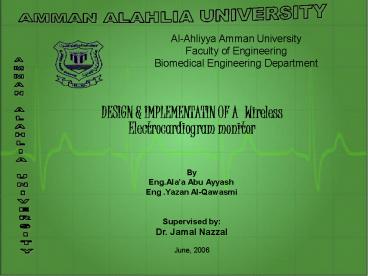ECG Tester PowerPoint PPT Presentation
1 / 31
Title: ECG Tester
1
AMMAN ALAHLIA UNIVERSITY
Al-Ahliyya Amman UniversityFaculty of
EngineeringBiomedical Engineering Department
AMMAN ALAHLIA UNIVERSITY
DESIGN IMPLEMENTATIN OF A Wireless
Electrocardiogram monitor By
Eng.Alaa Abu Ayyash Eng
.Yazan Al-Qawasmi Supervised by Dr. Jamal
Nazzal June, 2006
2
WIRELESS ECG
3
Electrocardiographs
- Heart activity causes electrical changes
throughout the body, with every heartbeat. - ECG can detect these voltage changes on the skin.
- Output is printed in paper
- or on a computer screen.
4
INTRODUCTION
- The electrocardiogram (ECG or EKG) is a
- noninvasive test that is used to reflect
- underlying heart conditions by measuring
- the electrical activity of the heart. By
- positioning leads (electrical sensing devices)
on the body in standardized locations,
5
INTRODUCTION
- ECG can be used to
- the rate and regularity of heartbeats
- The position of the chambers
- the presence of any damage to the heart
- effects of drugs and devices used to regulate the
heart - provide diagnosis when someone has chest pains or
palpitations.
6
ECG WAVEFORM
- The QRS complex is where the stronger ventricles
- fire, pushing blood through the pulmonary
- artery to the lungs, and through the aorta to the
- Body.
7
ECG WAVEFORM
- The P wave is seen. This corresponds to
- both the atrium contracting (depolarizing) and
- priming the ventricle with blood.
- The T wave is the time at which the
- ventricles repolarize themselves for the next
- beat
8
How to detect ECG Waveform
- Leads are placed on the body in several
- pre-determined locations, usually the extremities
or the front of the chest, to provide information
about heart conditions.
9
ECG-12 LEAD
10
TYPICAL ELECTROCARDIOGAM
11
PROJECT
- For our final project, we implemented a
- wireless electrocardiogram monitor
12
High-Level Design
13
INPUT SIGNAL
- Three leads are placed on the subject
- usually one on each side of the chest and
- on the lower abdomen, This signal is sent
- to the amplifier .
14
Amplifier Circuit
G150K\RG
15
Cont.. Amplifier Circuit
- Signal is sent to the amplifier where it
- is amplified by a factor of one thousand.
- With the reference lead of the subject
- placed to ground.
16
Cont.. Amplifier Circuit
- Also we can calculate the Gain from this
- equation G150K\RG By Using a 4.7k
- resistor, a gain of 11.7 results from this
- Stage.
INA121
17
Cont.. Amplifier Circuit
- Following the instrumentation amp, the signal is
passed through two 10 uF capacitors, placed back
to back. The capacitors are used to prevent
baseline drift in the ECG signal.
18
VOLTAGE TO FREQUENCY CONVERTER
- The signal is then sent to the voltage to
- frequency converter (VFC), which converts
- the signal to a frequency so that it can be
- transmitted
19
VOLTAGE TO FREQUENCY CIRCUIT
20
Cont.. VOLTAGE TO FREQUENCY CONVERTER
- The LM231/LM331 family of voltage-to-
- frequency converters.
- The output when used as a voltage-to-
- frequency converter is a pulse train at a
- frequency precisely proportional to the
- applied input voltage.
21
TRANSMITTER CIRCUIT
- The following schematic describes the
- source-splitting and transmitter section of
- our project
22
TRANSMITTER CIRCUIT
FM transmitter, turning a wire 4 times around the
pen allows the signal to be transmitted at 90 MHz.
23
RECEIVER CIRCUIT
- This section consists a summing amplifier
- with a gain of one cascaded with an
- inverting amplifier with a gain of
- approximately two.
24
RECEIVER CIRCUIT
- The summer takes the input obtained from
- the receiver (a FM radio tuned at
- approximately 90 MHz) and adds it to a
- constant voltage obtained using a simple
- voltage divider.
25
RECEIVER CIRCUIT
26
FREQUENCY TO VOLTAGE CONVERTER
- The following figure shows the FVC circuit.
27
FREQUENCY TO VOLTAGE CONVERTER
28
FREQUENCY TO VOLTAGE CONVERTER
- Equation used to calculated the voltage
- output due to the frequency response
- obtained from the LM231 data sheet
29
RESULT
- the output signal is displayed on an oscilloscope
30
OUTPUT SIGNAL
31
Al-Ahliyya Amman UniversityFaculty of
engineeringbiomedical engineering department
Special thanks for
Dr.Jamal Nazzal Dr.Sameh
Al-Sharo Dr. Ousama Aamar By Eng.Alaa Abu
Ayyash Eng.Yazan Al-Qawasmi June, 2006

